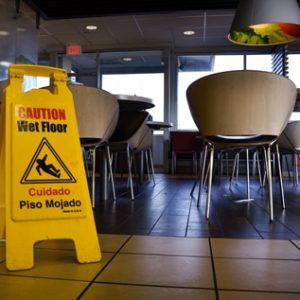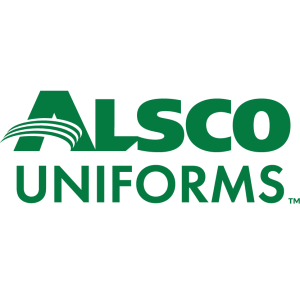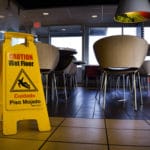
Slapstick comedy has made slipping and falling seem funny, but it is in fact an extremely serious matter, especially if you are a business owner.
Every year, companies lose huge amounts of money because of slips and trips and the lost production they usually bring with them. As a matter of fact, slips and trips made up more than 50 percent of all injuries at workplaces.
This all shows that proper care of wet areas in your company’s premises is among the essential parts of your management efforts.
Alsco is proud to be a part of the solution, with a wide selection of water absorbent floor mats, designed to be slip resistant and create safe areas to walk on.
Alsco mats are suitable for any part of the building, whether it is a lobby, a hall or a washroom.
Understanding The Problem
To be honest, it is pretty hard to find statistics that are related specifically to the “washroom incidents”, but there is a good deal of records about accidental falls, which fits slips and trips into its category.
These accidental injuries continue to happen, and worldwide workplaces registered various “falls on the same level” (which includes slips and trips), or a percentage of around 10% of the total number of work-related injuries and illnesses over the 12-month period.
In the UK, the Health and Safety Executive (HSE) revealed that the vast majority of about 1,300 registered incidents of slips and trips in the food and drinks industry (pubs and restaurants etc) are accounted for by slips (80%), and of them 90% were caused by wet floors.
Meanwhile, the US reports 540,000 serious slip and fall injuries in the workplace on average each year, with as many as 460 workplace fatalities directly related to slips on wet floors.
It can also be pretty expensive to ignore workplace safety regulations. For example, the penalties for acting in violation of OSHA in Malaysia can be harsh – up to 10,000-ringgit fine, or up to one-year imprisonment, or both.
The importance of these problems at a workplace is crystal clear, but there is no reason for this threat to remain so high. Appropriately managing wet areas in your workplace is not at all a complicated project, and there are several simple steps that can be followed to considerably reduce the risk of slipping and falling on the wet floor, in the kitchen, the washroom or anywhere else.
Areas Of Critical Importance
No matter what the nature of your business is, slips and trips are always a risk – even in offices with carpets, staff can trip over a dog-eared carpet corner and get injured in the fall. Wet areas are usually confined to specific locations, however, and while statistics fail to identify the precise location of incidents involving wet surfaces, common knowledge tells us they are confined to 6 main areas. These are the
- front and rear entrances, where rainwater is carried in on wet shoes, clothes and umbrellas,
- warehouses and workshops where machinery oils, detergents and other liquid chemicals might spill.
- lobbies and waiting rooms, again where water from outdoors can be allowed to drip
- canteens, where spills can occur during break and lunchtime. Also, cisterns dispensing hot or cold drinks, and refrigerated display units may leak.
- kitchens, where water, grease, oil and moist ingredients can fall to the ground. Also refrigerators and other temperature-controlled food storage units might leak.
- washrooms, where splashing around sinks, overflowing toilets and leaking pipes can lead to wet areas
Of course, any areas where there is a normally smooth surface – like marble floors or ceramic tiled floors – are aesthetically impressive and easy to clean, but they become hazardous surfaces should there be spillage at all.
Suggested Actions To Prevent Accidents
As with all health and safety issues, there are always various steps you can take to counter the likelihood of there even being an accident. As a matter of fact, managing wet floors at entrances, lobbies an washrooms is probably the best of all the safety-related tasks in any working environment.
We have made you a shortlist of the top 5 tips for managing wet areas anywhere at a workplace and in that way protecting staff and visitors from the threat of slipping and suffering an injury – or worse.
1. Stop People From Accessing Wet Areas
The first step you should make is to block the area, that is, to preventing anyone entering the areas where there are wet surfaces. This is always important, even when there are several people in the area, but especially if the wet areas are with frequent traffic like those in medium to large offices or where customers might visit too.
There is a variety of options available for you to secure these areas, such as portable plastic barriers that can be hooked together to surround the danger zone. These can also have retractable canvas belts, which are ideal for blocking off large spillages, or expandable barriers with scissors-action plastic slats, which are perfect from cordoning off smaller areas.
2. You Need To Put Adequate Warning Signs
You need to consider clearly marking wet floors whenever and wherever they appear. For this purpose you can use one of the standard signs which are available everywhere, with a “Caution! The floor is wet!” message written on them. You need to place the signs strategically well – placing them on the wet floor is a mistake, since by the time people see them they may have already stepped on the wet surface and risk falling.
It is also very important that the signs aren’t covered by something, and that it is impossible to pass the sign without actually reading it.
There are two types of signs you need to consider getting. The first type is the removable sign, portable enough that you can carry it in your hands and deliver it where necessary as soon as a situation arises.
The second type is the one which gets fastened on the wall and is usually placed in washrooms, around sinks, but also around windows on which the water can condensate and drip on the floor.
Consider also introducing “spillage reporting” and train employees to report on wet floors in the building whenever and immediately after they see one.
3. Promote Awareness
We have already mentioned that spillages should be clearly marked, and not kept a secret. Another very important thing is to make sure that everyone is aware of of the risks at all times. After all, vigilance is an essential tool when it comes to staying safe and keeping standards high.
So, consider putting up posters in areas to promote awareness of the risks, for example on corridors, in the canteen, and, of course, in the workplace office itself. You will see that there are plenty of signs to download for this particular purpose. The only thing to do is make sure that they are big enough and can be easily seen, which means they should not be a small A4-sized print and hidden behind or an open boardroom door.
4. Be Ready For Quick Reactions
Acting on all of those tips will definitely result in more safety for everyone working in or visiting your business. There is, however, something that undoubtedly wins as the most efficient method for eliminating slipping risk and that is quick action.
If spillage is removed before anyone manages to even reach the place where it occurred, there will be absolutely no chance an incident would happen.
In order to enable quick reaction times, you need to consider your cleaning closet distribution across the building and plan employing the sufficient number of cleaning staff to be able to react as soon as possible.
These closets need to be placed at strategic places and they always need to be adequately stocked with all the necessary equipment, such as buckets and mops, liquid absorbing materials, etc. Cleaning closets don’t have to be big, but in that case you need to organize them well enough to fit everything. Also, consider appointing a member of your staff to ensure closets are always kept well stocked.
5. Choose Floor Mats Properly And Establish Good Cleaning Schedule
We have already identified toilets as areas that are always critical because here spillage can occur at any time. Even though keeping them spillage free should be a priority, there are still ways to prevent risks of dangerous falls before dangers even occur.
For example, Floor mats are an ideal solution for areas which are slippery all the time. The new technology is what makes these mats able to soak up a lot of liquid and still provide a safe surface.
Alongside materials, floor mat design is also important, because it prevents the mat from sliding on the wet floor.
It should be wise to put a mat on every permanently or frequently wet surface. At Alsco, we provide a variety of floor mats specifically designed to handle wet areas and reduce the risk of slipping. Different work areas demand different floor mats. For example, there are thick mats that let liquid and debris to fall through while keeping workers above the spillage and allowing them to work on. These are popular in workshops and kitchens, but can also be equally effective in washrooms around sink areas.
For more on Alsco Mats, make sure to check out our online brochure.
Apart from reacting on time, it is also important to set a fix cleaning schedule which will keep the workers safe and the building clean.
The morning is the best time for the general cleaning to take place. Be it before everyone comes in or after everyone has left. The first is more desirable (cleaning staff will not like it if they have to stay at work for such a long time), even though it requires some serious planning. If your employees come to work at, say, nine o’clock, it is wise to do the cleaning at least one or two hours earlier.
Timely cleaning will ensure that there are no wet areas left when workers arrive, which helps with general safety at work and makes cleaning itself more efficient, since dirty shoes can make quite a mess on a wet floor.
Alsco Mats Are The Solution For Your Problems
Throughout the years, Alsco has became a trusted name in the textile rental industry because it serves a variety of industrial services. When it comes to managing wet floors in kitchens, washrooms, corridor or lobbies, Alsco Mats provide floorcare solutions for every situation.
Alsco provides a complete mat rental service which is a great deal, because our clients avoid the often high costs related to purchases. Rental service includes maintaining and replacing floor mats in the workplace, with weekly rates starting from less than a $1 a day.
Key benefits of our mat rental services are: Complete managed service, Tax deductible advantages, clean floors and prevention of floor damages, no capital outlay and a clean image to your staff and customers.
If you would like to find out more about how Alsco Mats can contribute to your workplace in a affordable and reliable way, please visit our website. You can also check out our range of floor mats on our brochure. Last but not the least, if you would like to speak to someone from our experienced team, you can fill out our online enquiry form, or call us at +60 3-5191 77 66.
Photo courtesy of Flickr Images by r. nial bradshaw


LEAVE A REPLY
Your email address will not be published. Required fields are marked *
You must be logged in to post a comment.